Alergija je reakcija/odziv telesa na nekatere snovi ali alergene, kot so nekatera živila, cvetni prah, čebelji strup, prah ali celo dlake hišnih ljubljenčkov. Simptomi alergijske reakcije so zelo različni in so povsem blagi do zelo intenzivni ter ponavadi vključujejo: srbečico, izpuščaje, kihanje, kašljanje in otekanje.
ALERGIJA: Kaj je alergija? | Simptomi | Vrste alergij | Diagnostika | ZDRAVLJENJE | Konvencionalno zdravljenje | Alternativa | Najbolj pogoste alergije | Preprečevanje | Vprašanja in odgovori | Viri/reference
Alergije se pojavijo, ko se imunski sistem odzove na tuje snovi - pravimo jim alergeni. Vaš imunski sistem proizvaja snovi, znane kot protitelesa. Ko imate alergije, vaš imunski sistem tvori protitelesa, ki identificirajo določen alergen kot škodljiv, čeprav to morebiti niti ni. Ko pridete v stik z alergenom, lahko reakcija vašega imunskega sistema vname kožo, poslabša stanje sinusov, dihalnih poti ali prebavnega sistema.
Resnost stanja alergij se razlikuje od osebe do osebe in lahko obsega od zgolj manjšega draženja pa vse do anafilaksije – potencialno smrtno nevarnega izrednega stanja, ki je posledica izrazito resne preobčutljivostne reakcije.
Video vsebina: Kaj so alergije?

Čeprav večine alergij ni mogoče pozdraviti, lahko zdravljenje pomaga pri lajšanju simptomov alergije.
Ko oseba, ki je alergična na določen alergen, pride v stik z njim, se izrazi alergijska reakcija:
- Ko alergen (kot je denimo cvetni prah) vstopi v telo, sproži odziv protiteles.
- Pričnejo se tvoriti protitelesa - predvsem IgE.
- Ko cvetni prah pride v stik s protitelesi, se ta vežejo na površino alergena
- Prisotni mastociti se ob prisotnosti alergena nemudoma odzovejo s sproščanjem histamina.
- Kadar je sproščanje histamina posledica prisotnosti alergena, je posledično vnetje (pordelost in oteklina) dražeče in neprijetno.

Podobne reakcije se lahko pojavijo v prisotnosti nekaterih kemikalij in prisotnosti aditivov v živilih.
Pogosti simptomi alergije
Simptomi alergije se razlikujejo od osebe do osebe in so lahko različni glede na vrsto alergije.
Sezonski ali okoljski simptomi alergije vključujejo:
- izcedek iz nosu, običajno s prozorno ali bledo belo sluzjo
- kihanje
- kašelj
- rdeče, solzne oči
- srbenje okoli nosu, ust ali oči
Če se ti simptomi ne zdravijo, lahko povzročijo druge težave, kot so zamašen nos, glavoboli, vneto grlo in druge težave, zato je zdravljenje izrednega pomena.
Video vsebina: 7 znakov, da imate alergijo in ne prehlad.

Alergijski simptomi so lahko tudi zelo resni in smrtno nevarni ter vodijo v anafilaksijo.
Simptomi, zaradi katerih boste morda morali poiskati nujno pomoč, vključujejo:
- Koža: srbenje, rdečina, oteklina in koprivnica.
- Usta: srbenje, otekanje ustnic in jezika.
- Želodec: bruhanje, driska, krči.
- Dihala: težko dihanje, piskajoče dihanje, kašelj, bolečine v prsih in/ali tiščanje.
- Srce: šibek utrip, omotica, omedlevica.
- Glavobol, zamašen nos, solzenje oči, znojenje.
- Zmedenost, občutek bližajoče se izgube.
- Izguba zavesti.
Vrste alergij
Alergije niso le nadloga – so pravzaprav resen zdravstveni problem.
Video vsebina: 10 različnih tipov alergij.

Alergije lahko ovirajo vsakodnevne dejavnosti in vplivajo na kakovost življenja. Na splošno spadajo v dve kategoriji:
Okoljske alergije
Pod okoljske alergije spadajo:
- cvetni prah
- plesen
- domače živali
- pršice
- piki žuželk
- miši in izločki le-teh
Življenjsko nevarne alergije
Nekateri alergeni, ki lahko zaradi izpostavljenosti povzročijo resne, celo življenjsko nevarne alergijske reakcije (imenovane anafilaksija).
Ti alergeni so običajno:
- hrana (specifične kategorije)
- strupi žuželk (vbodi os, čebel, sršenov)
- lateks
- zdravila
Diagnosticiranje in testiranje alergij
Pomembno je vedeti, kateri alergeni povzročajo simptome.
Slika: izgled načina testiranja alergij na določene sestavine.
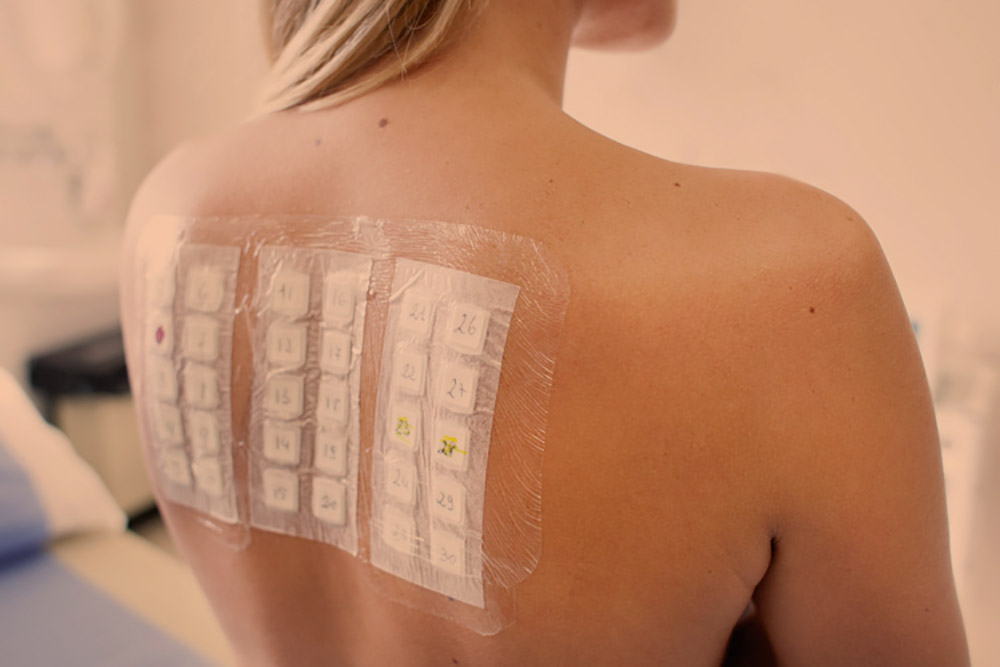
Če želite pridobiti diagnozo in testirati alergije, se morate posvetovati s certificiranim alergologom.
Alergolog bo naredil naslednje:
- pregled vaše zdravstvene kartoteke in zdravstvene zgodovine vaše družine
- vprašanja o pogostosti in resnosti vaših simptomov
- vprašanja, glede dejavnosti, ki bi vas lahko izpostavile alergenom
- vprašanja o vašem domačem in delovnem okolju
- fizični pregled oči, ušes, nosu in pljuč
Na podlagi izvidov se lahko alergolog odloči, ali je potrebno alergotestiranje. Testiranje alergij lahko vključuje testiranje kože in krvne preiskave. Nato lahko skupaj s svojim alergologom prediskutirate rezultate in se odločite za ustrezen načrt zdravljenja.
Zdravljenje
Konvencionalno zdravljenje
Trenutno je na voljo več možnosti zdravljenja alergij, vključno z:
- zdravljenje z zdravili
- zdravljenje z alergensko imunoterapijo
- zdravljenje z pršili in pršili za nos
- izogibanje alergenom
Zdravila, ki se uporabljajo za zdravljenje alergij, vključujejo sledeče skupine:
- Antihistaminiki
- Dekongestivi
- Kortikosteroidna pršila za nos
Video vsebina: 3 naravni načini za zdravljenje alergij.

- Modifikatorji levkotriena
- Stabilizatorji mastocitov
- Antiholinergiki
Alergenska imunoterapija
Imunoterapija proti alergenom, znana tudi kot injekcije proti alergijam je postopek, ki pomaga izboljšati oziroma izgraditi vašo toleranco na alergene ter zelo pomembno tudi zmanjšati ali odpraviti simptome. Deluje tako, da se bolniku po rednem urniku postopoma povečuje količina alergena, dokler ni dosežena vzdrževalna raven.
Toleranca na alergen se običajno nadaljuje po koncu imunoterapije – vendar se stopnja dolgoročnega uspeha razlikuje od osebe do osebe.
Alergijske injekcije in tablete pod jezik so vrste imunoterapije, ki vam jih lahko alergolog priporoči za zdravljenje. Obiščite svojega alergologa, da določi najboljšo možnost zdravljenja za vas.
Imunoterapija je posebna vrsta zdravljenja, pri kateri bolnikom dajemo majhne količine alergena, da bi se na dolgi rok učinkovito spopadli z alergijskimi reakcijami. Gre za postopek, ki seizvaja pod zdravniškim nadzorom in lahko traja več let. To zdravljenje lahko pomaga zmanjšati intenzivnost alergijskih simptomov in celo lahko prepreči pojav hudih epizod.
Alternativno zdravljenje alergij
Homeopatija
Homeopatija temelji na ideji, da lahko zdravljenje tovrstnih alergij, s katerimi se soočate pričnemo z homeopatskimi zdravili, ki so bila izdelana iz alergena samega, vendar v precej manjših količinah. Omenjena homeopatska zdravila so običajno narejena iz ponavadi naravnih snovi, ki so pomešane z večjimi količinami škroba ali sladkorja, da bi se izognili kakršnemu koli neželenim stranskim učinkom. Homeopatska zdravila so običajno na voljo v obliki granul, praškov ali kapljic in so na voljo v lekarnah. V Slovenskih lekarnah se večinoma tržijo predvsem homeopatska zdravila v obliki granul.
Akupunktura
Akupunktura je drug način oziroma pristop v primeru alergijskih reakcij. Gre za tehniko uporabe zelo tankih igel, ki se zabadajo na določenih mestih človeškega telesa.
Akupunktura temelji na predpisih stare in tradicionalne kitajske medicine. Večinoma se z akupunkturo rešujejo sledeči simptomi: bolečina, nadzor nad stresom, osteoartritis, menstrualni krči, bolečina v vratu, teniški komolec, fibromialgije.
Slika: simptomi alergijskih reakcij so lahko sila neprijetni.

Pogosto ima lahko blagodejne učinke na simptome alergijske reakcije vključno z izpuščaji, kihanjem, rdečico in srbenjem.
Refleksologija
Refleksologija je tehnika masaže, ki vključuje občutljive točke na nogah in rokah - izvaja se z namenom, da bi se izboljšalo splošno zdravje posameznika. Ta tehnika se lahko uporablja tudi za zdravljenje težav s sezonskimi alergijami, saj lahko pomaga odpraviti simptome, kot so izpuščaji, srbenje, kihanje, kašljanje in otekanje. Pogosto je namen te tehnike lajšanje stresa, ki vas bremeni, s tem v povezavi pa se zmanjšajo tudi vsi simptomi, ki so s stresom povezani. Pogosto je namen te tehnike lajšanje stresa, ki vas bremeni, s tem v povezavi pa se zmanjšajo tudi vsi simptomi, ki so s stresom povezani.
Najbolj pogoste alergije
Številne različne snovi iz okolja sprožijo alergijske simptome.
Pogosti alergeni vključujejo:
Alergija na hrano
Alergeni so predvsem sledeči: kravje mleko, kokošja jajca, arašidi, drevesni oreščki, pšenica, soja, ribe, lupinarji. Alergija na hrano je v praksi manj pogosta kakor intoleranca na hrano.
Video vsebina: več o alergiji na hrano.

Več o tovrstnih alergenih v gornjem videu.
Alergija na cvetni prah
Alergija na cvetni prah je alergija na drobne delce, ki jih sproščajo drevesa, trave in pleveli.
Simptomi so ponavadi sledeči:
- kihanje
- solzne ali srbeče oči
- kašelj
- srbeče grlo
- zamašen nos
Ta vrsta alergije se pojavlja skozi vse leto. Pelodi dreves so pogosti pozno pozimi in zgodaj spomladi, pozno spomladi in poleti pa mu sledijo cvetni prah trav. Potem pa so proti koncu poletja pogostejše alergije na cvetni prah, ki ga sprošča plevel, kot je ambrozija.
Video vsebina: več o alergijah na cvetni prah in kako jih zdravimo.

Obstajajo načini za omejitev izpostavljenosti alergenom cvetnega prahu in zmanjšanje simptomov, vendar pa lahko alergije na cvetni prah zahtevajo redno uporabo zdravil za nadzor simptomov. Z omenjenimi težavami se je v tovrstnih primerih potrebno o možnostih zdravljenja pogovoriti s pooblaščenim alergologom.
Alergija na plesen
Plesni so mikroskopski organizmi, imenovani glive, ki jih najdemo skoraj povsod, v zaprtih predvsem vlažnih prostorih in zunaj. Plesni se razmnožujejo s sporami, te pa se širijo z vodo, žuželkami ali zrakom in so tako majhne in lahke, da lahko celo lebdijo v zraku. Te spore je mogoče vdihniti in posledično povzročiti simptome alergije.
Ti simptomi so pogosto sledeči:
- Zamašenost nosu in sinusov
- Vneto grlo
- Kihanje
- Solzne ali pekoče oči
- Suh kašelj
- Zasoplost
- Draženje nosu, grla ali kože
Spore plesni so še posebej nevarne za ljudi z astmo in lahko sprožijo nevarne napade astme, natančnejši razlog žal ni poznan.
Video vsebina: sprožilci alergije v povezavi s plesnijo.

Testiranje na alergijo na plesen opravi pooblaščen alergolog in lahko vključuje preiskave kože kot tudi krvi.
Zdravljenje alergij na plesen lahko vključuje sledeča zdravila:
- Nazalni kortikosteroidi
- Antihistaminik
- Dekongestivi
- Montelukast (Singulair) - zdravljenje alergij v povezavi z astmatičnimi bolniki.
Plesen se skriva tako v zaprtih prostorih kot na prostem, zato je omejitev izpostavljenosti sporam plesni ključna.
Alergija na hišne ljubljenčke
Alergijske reakcije na mačke, pse in druge dlakave živali ponavadi povzročajo beljakovine, ki jih najdemo na površini kože hišnih ljubljenčkov, imenovanih "prhljaj", pa tudi v njihovi slini in urinu jih je mogoče zaslediti.
Alergeni hišnih ljubljenčkov lahko povzročijo sila neprijetne reakcije, ko jih vdihavamo, pridejo v oči ali pridejo v stik s kožo. Reakcije se lahko pojavijo v nekaj minutah, lahko pa tudi za več ur po stiku z alergenom.
Video vsebina: 15 načinov za minimiziranje alergij v primeru posedovanja hišnega ljubljenca.

Najboljši način za odpravo alergije na hišne ljubljenčke je, da hišnega ljubljenčka odstranite od doma. Vendar pa lahko dlaka hišnih ljubljenčkov ostane v vašem domu še več tednov do mesecev.
Alergija na pršice
pršice so drobne žuželke, ki živijo v vzmetnicah, blazinah, oblazinjenem pohištvu. Vlago iščejo skupaj s svojo najljubšo hrano, drobnimi koščki odvržene človeške kože. Alergeni iz iztrebkov pršic in trupel se nabirajo v posteljnini, pohištvu in prahu, nato pa ob stiku dražijo dihalne poti in oči.
Simptomi alergije na pršice vključujejo:
- srbeče oči,
- praskajoče grlo,
- izcedek iz nosu in
- drugi simptomi alergije
- Pršice so tudi močan sprožilec astme.
V svojem domačem okolju lahko naredite nekaj sprememb, da zmanjšate število pršic.
Video vsebina: alergija na pršice - simptomi in zdravljenje

Alergije na pršice lahko zdravite z dekongestivi brez recepta, antihistaminiki ali pršili za nos. Za pogovor o zdravilih in imunoterapiji poiščite pomoč alergologa s certifikatom.
Alergija na ščurke in miši
ščurki in miši so večinoma nočne živali/škodljivci, ponoči iščejo hrano in vodo – in za seboj puščajo sledi alergenov, ki povzročajo simptome ob stiku ali vdihavanju. Alergeni ščurkov so predvsem iztrebki, slina in deli telesa. Alergeni miši so koža, slina in urin.
Video vsebina: več o alergiji na ščurke.

Ravni alergenov so običajno najvišje na kuhinjskih omaricah in tleh, medtem ko so kopalnice z vlago sekundarne površine. Slabo zaprta hrana in odpadki v kuhinjah so dobro znan dejavnik tveganja. Spalnica je še enaizmed elitnejših lokacia za ščurke, zlasti v močno okuženih domovih.
Najboljši način za odstranjevanje miši iz doma so pasti za miši; postavite jih ob stene, kjer poteka pogosto pot miši, kjer iščejo hrano. Pri hudih okužbah je morda najbolje, da pokličete profesionalnega uničevalca. Manjše izboljšave doma lahko izboljšajo vaše možnosti, da preprečite infestacije s ščurki in mišmi.
Alergija na strup insektov
Za večino ljudi so piki žuželk kratkotrajna in malce boleča nadloga. Drugim ljudjem, ki so morebiti alergični na strup žuželk, pa lahko vbodi le-teh povzročijo sila neprijetno alergijsko reakcijo, lahko celo življenje ogožajočo. Simptomi alergije na strup žuželk lahko segajo torej od blage lokalne reakcije pa vse do hude sistemske reakcije, znane kot anafilaksija. Nevarnost je predvsem ta, da se lahko alergijska reakcija pojavi pri komurkoli, tudi pri ljudeh, ki jo do tedaj niso imeli.
Video vsebina: vse kar želite vedeti o alergijah na strup insektov.

Lokalne reakcije je mogoče obvladati doma predvsem s hladnimi obkladki, antihistaminiki ali kremami za srbenje. Če pa imate znano alergijo na žuželke, morate vedno nositi avtomatski injektor za epinefrin.
Alergija na lateks
je alergijska reakcija na beljakovine, ki so prisotne v mlečnem soku kavčukovca (Hevea brasiliensis). Alergija na lateks se običajno razvije po ponavljajoči se izpostavljenosti medicinskim in potrošniškim izdelkom, ki vsebujejo lateks naravnega kavčukovca.
Alergija na lateks lahko predstavlja resno tveganje za zdravje pri ljudeh, ki so:
- zdravstveni delavci
- bolniki s spino bifido
- delavci s poklicno izpostavljenostjo tovrstnemu alergenu
- bolniki z več zaporednimi operacijami
Simptomi alergije na lateks so lahko sprva sicer blagi, vendar lahko napredujejo v resnejše vrste simptomov.
Video vsebina: vzroki, simptomi in tipi alergij na lateks.

Alergijska reakcija na lateks lahko povzroči tudi anafilaksijo, smrtno nevarno alergijsko reakcijo.
Alergija na zdravila
lahko povzroči koprivnico, omotico, slabost, težave z dihanjem, želodčne krče ali povzročijo celo nevarno otekanje grla ali ust. Simptomi se lahko pojavijo v nekaj trenutkih po zaužitju zdravila ali do nekaj ur kasneje.
Zdravila, ki najpogosteje povzročijo reakcijo, vključujejo:
- Antibiotike
- Nesteroidna protivnetna zdravila (NSAID), kot denimo ibuprofen
- Zdravila, ki se uporabljajo pri anesteziji
- Insulin (redkeje)
- Kemoterapevtike
Če se vam v nekaj urah po zaužitju zdravila pojavi nenadna rdečica ali koprivnica, pokličite ambulanto alergologa.
Video vsebina: alergije na zdravila.

Če so simptomi hudi in vključujejo več telesnih organov – denimo: kožni izpuščaj, težave z dihanjem in prebavne težave – gre lahko za anafilaksijo. Pokličite 112, s pomočjo sorodnika se nemudoma odpravite na urgentni oddelek.
Vse reakcije niso alergija na zdravila, zato je pomembno, da vas testira certificirani alergolog in preveri morebitno življenjsko ogroženost.
Preprečevanje alergij
Tu je nekaj nasvetov, s katerim lahko preprečite nastanek alergij:
- Izogibajte se potencialnim alergenom, predvsem na način da izberete hipoalergene proizvode in se kolikor je mogoče izogibate stikom s potencialnimi alergeni.
- Uporabljajte vlažilce za zrak, da preprečite prekomerno suhost zraka in se posledično izognite draženju oči.
- Izogibajte se prahu in prašnim delcem, tako da redno čistite svoj dom in se posledično izogibajte stiku z odpadlimi lasmi, prahom in živalskim dlakam.
- Uporabljajte filtre za zrak, da se izognete potencialnim alergenom.
- Ne preobremenjujte svojega imunskega sistema s preveliko telesno dejavnostjo.
Vprašanja in odgovori
Katerih je 7 najpogostejših simptomov alergije?
Simptomi alergijske reakcije, ki so najpogostejši:
- Srbeče, solzne oči.
- Srbeč nos.
- Kihanje.
- Smrkav nos.
- Izpuščaji.
- Koprivnica (izpuščaji z izbočenimi rdečimi lisami).
- Krči v želodcu.
- Bruhanje[1].
Kako pozdraviti alergijo?
- preizkusite zdravilo brez recepta - po zdravniškem predpisu.
- uporabite peroralni antihistaminik. Antihistaminiki namreč lahko pomagajo ublažiti kihanje, srbečico, zamašen nos ali izcedek iz nosu ter morebitno solzenje oči...
- preizkusite kortikosteroidna pršila za nos - po predpisu zdravnika.
- uporabite dekongestive[2].
Kako dolgo bo trajala alergijska reakcija?
Običajna tovrstna reakcija ne traja več kot 24 ur, vsekakor pa je lahko sila neprijetna. Koprivnica denimo se lahko pojavi kjerkoli na telesu v različnih oblikah in razsežnostih.
Alergijski rinitis: Alergijski rinitis, imenovan tudi seneni nahod, se pojavi, ko se vaš imunski sistem pretirano odzove na alergen, ki ga vdihnemo (plesen, prah, dlaka psov ali mačk)[3]. Reakcija vašega imunskega sistema pa povzroči vse simptome, ki sledijo.
Viri in reference
Vir: Družinski zdravstveni vodnik. Konvencionalno in alternativno zdravljenje, Dr. Jajo Lajovic, Založba Mladinska knjiga
1. What Is an Allergy? - https://aafa.org
2. What Is an Allergy? - https://www.mayoclinic.org
3. What Are the Four Types of Allergic Reactions? - https://www.advancedentdenver.com

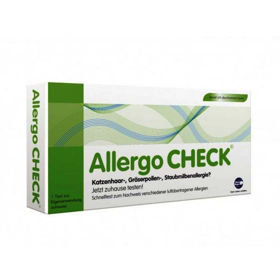
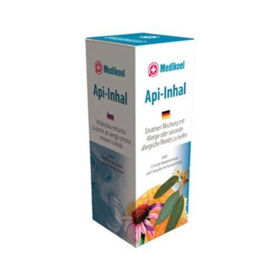
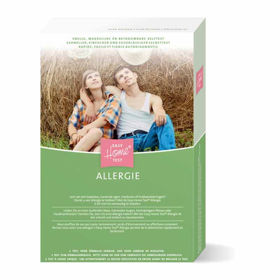

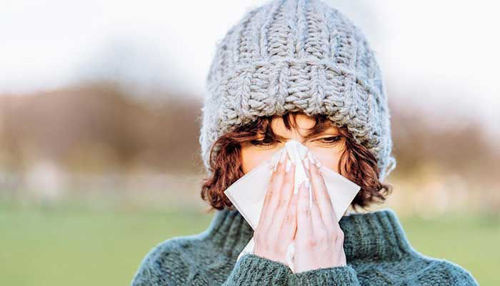
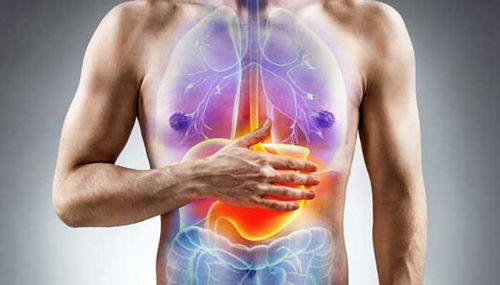

 Facebook
Facebook
 Instagram
Instagram
 info@moja-lekarna.com
info@moja-lekarna.com

